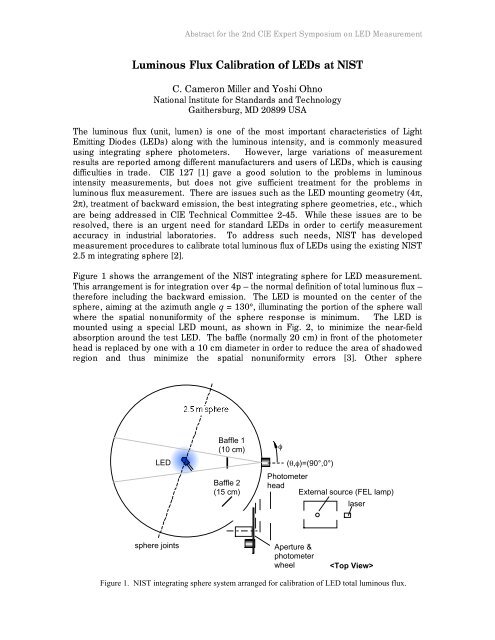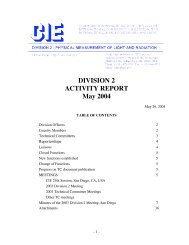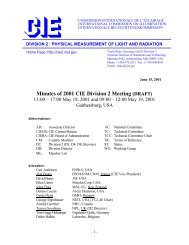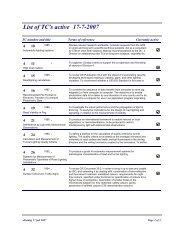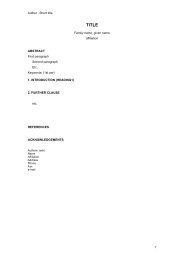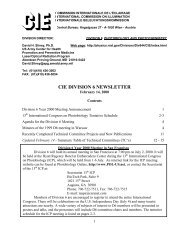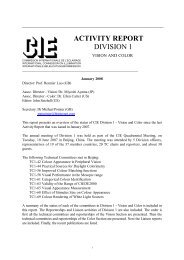Luminous Flux Calibration of LEDs at NIST - cie
Luminous Flux Calibration of LEDs at NIST - cie
Luminous Flux Calibration of LEDs at NIST - cie
You also want an ePaper? Increase the reach of your titles
YUMPU automatically turns print PDFs into web optimized ePapers that Google loves.
Abstract for the 2nd CIE Expert Symposium on LED Measurement<br />
<strong>Luminous</strong> <strong>Flux</strong> <strong>Calibr<strong>at</strong>ion</strong> <strong>of</strong> <strong>LEDs</strong> <strong>at</strong> <strong>NIST</strong><br />
C. Cameron Miller and Yoshi Ohno<br />
N<strong>at</strong>ional Institute for Standards and Technology<br />
Gaithersburg, MD 20899 USA<br />
The luminous flux (unit, lumen) is one <strong>of</strong> the most important characteristics <strong>of</strong> Light<br />
Emitting Diodes (<strong>LEDs</strong>) along with the luminous intensity, and is commonly measured<br />
using integr<strong>at</strong>ing sphere photometers. However, large vari<strong>at</strong>ions <strong>of</strong> measurement<br />
results are reported among different manufacturers and users <strong>of</strong> <strong>LEDs</strong>, which is causing<br />
difficulties in trade. CIE 127 [1] gave a good solution to the problems in luminous<br />
intensity measurements, but does not give suffi<strong>cie</strong>nt tre<strong>at</strong>ment for the problems in<br />
luminous flux measurement. There are issues such as the LED mounting geometry (4π,<br />
2π), tre<strong>at</strong>ment <strong>of</strong> backward emission, the best integr<strong>at</strong>ing sphere geometries, etc., which<br />
are being addressed in CIE Technical Committee 2-45. While these issues are to be<br />
resolved, there is an urgent need for standard <strong>LEDs</strong> in order to certify measurement<br />
accuracy in industrial labor<strong>at</strong>ories. To address such needs, <strong>NIST</strong> has developed<br />
measurement procedures to calibr<strong>at</strong>e total luminous flux <strong>of</strong> <strong>LEDs</strong> using the existing <strong>NIST</strong><br />
2.5 m integr<strong>at</strong>ing sphere [2].<br />
Figure 1 shows the arrangement <strong>of</strong> the <strong>NIST</strong> integr<strong>at</strong>ing sphere for LED measurement.<br />
This arrangement is for integr<strong>at</strong>ion over 4p – the normal definition <strong>of</strong> total luminous flux –<br />
therefore including the backward emission. The LED is mounted on the center <strong>of</strong> the<br />
sphere, aiming <strong>at</strong> the azimuth angle q = 130°, illumin<strong>at</strong>ing the portion <strong>of</strong> the sphere wall<br />
where the sp<strong>at</strong>ial nonuniformity <strong>of</strong> the sphere response is minimum. The LED is<br />
mounted using a special LED mount, as shown in Fig. 2, to minimize the near-field<br />
absorption around the test LED. The baffle (normally 20 cm) in front <strong>of</strong> the photometer<br />
head is replaced by one with a 10 cm diameter in order to reduce the area <strong>of</strong> shadowed<br />
region and thus minimize the sp<strong>at</strong>ial nonuniformity errors [3]. Other sphere<br />
LED<br />
Baffle 1<br />
(10 cm)<br />
Baffle 2<br />
(15 cm)<br />
( )=(90°,0°)<br />
Photometer<br />
head<br />
External source (FEL lamp)<br />
laser<br />
sphere joints<br />
Aperture &<br />
photometer<br />
wheel<br />
<br />
Figure 1. <strong>NIST</strong> integr<strong>at</strong>ing sphere system arranged for calibr<strong>at</strong>ion <strong>of</strong> LED total luminous flux.
Abstract for the 2nd CIE Expert Symposium on LED Measurement<br />
arrangements remain the same as the normal<br />
configur<strong>at</strong>ion for calibr<strong>at</strong>ion <strong>of</strong> lamps. The test<br />
LED is measured using our detector-based<br />
method [2] in comparison with the beam flux<br />
introduced from the external source, which is<br />
approxim<strong>at</strong>ely 2 lm. In spite <strong>of</strong> the size <strong>of</strong> the<br />
sphere, we have enough signals for typical<br />
high-intensity <strong>LEDs</strong> having luminous flux <strong>of</strong> 0.1<br />
lm to 1 lm, in part to the high reflectance (~98<br />
%) <strong>of</strong> the co<strong>at</strong>ing. The photometer head is a<br />
temper<strong>at</strong>ure-monitored type with a built-in<br />
amplifier having gain ranges up to 10 9 V/A.<br />
The spectral mism<strong>at</strong>ch correction is applied by<br />
measuring the spectral power distribution <strong>of</strong><br />
each test LED and the total spectral Figure 2. The LED mount in the sphere.<br />
responsivity <strong>of</strong> the sphere system. The<br />
measurement uncertainty arising from the sp<strong>at</strong>ial nonuniformity <strong>of</strong> the sphere response<br />
has been analyzed for this particular sphere geometry using the measured sp<strong>at</strong>ial<br />
response distribution function (SRDF) and an LED model with a variable beam angles<br />
(Fig.3). Figure 4 shows the calcul<strong>at</strong>ed correction factors with respect to an isotropic<br />
point source, as a function <strong>of</strong> the LED beam angle. The measurement errors, if not<br />
corrected, are shown to be within 0.15 % for beam angles from 20° to 120° (Lambertian),<br />
which is taken into account in the uncertainty budget. The calibr<strong>at</strong>ion service for<br />
luminous flux <strong>of</strong> limited types <strong>of</strong> <strong>LEDs</strong> is now available <strong>at</strong> <strong>NIST</strong>. The expanded<br />
uncertainty (k=2) <strong>of</strong> the calibr<strong>at</strong>ion is from 0.6 % to 2 % depending on the color and<br />
other characteristics <strong>of</strong> the reference <strong>LEDs</strong>. A dedic<strong>at</strong>ed integr<strong>at</strong>ing sphere system for<br />
LED measurements and standard <strong>LEDs</strong> for luminous flux are to be developed.<br />
References<br />
[1] CIE Public<strong>at</strong>ion No. 127, Measurement <strong>of</strong> <strong>LEDs</strong> (1997).<br />
[2] Y. Ohno and Y. Zong, "Detector-Based Integr<strong>at</strong>ing Sphere Photometry,"<br />
Proceedings, 24 th Session <strong>of</strong> the CIE Vol. 1, Part 1, 155-160 (1999).<br />
[3] Y. Ohno and R. O. Daubach, “Integr<strong>at</strong>ing Sphere Simul<strong>at</strong>ion on Sp<strong>at</strong>ial<br />
Nonuniformity Errors in <strong>Luminous</strong> <strong>Flux</strong> Measurement”, J. IES, Winter 2001 issue (to<br />
be published).<br />
325 330335340345350355<br />
20°<br />
320<br />
0.8<br />
315 40°<br />
310<br />
305 60° 0.6<br />
300<br />
80°<br />
295<br />
0.4<br />
290 100°<br />
285<br />
280<br />
260<br />
255<br />
250<br />
245<br />
240<br />
235<br />
120°<br />
1<br />
0.2<br />
230<br />
225<br />
220<br />
215<br />
210<br />
205<br />
200<br />
195190185<br />
0<br />
0<br />
180<br />
5 10 15 20 25<br />
3035<br />
40<br />
45<br />
50<br />
130<br />
135<br />
140<br />
145<br />
150<br />
155<br />
160<br />
165<br />
175170<br />
55<br />
60<br />
65<br />
70<br />
75<br />
80<br />
85<br />
90<br />
95<br />
100<br />
105<br />
110<br />
115<br />
120<br />
125<br />
Figure 3. LED model <strong>of</strong> varied beam angle.<br />
Correction factor<br />
1.0015<br />
1.0010<br />
1.0005<br />
1.0000<br />
0.9995<br />
0.9990<br />
0.9985<br />
Series1<br />
0 30 60 90 120 150 180<br />
LED beam angle (degree) FWHM<br />
Figure 4. Correction factor for the sp<strong>at</strong>ial nonuniformity <strong>of</strong><br />
the sphere, for an LED model <strong>of</strong> varied beam angle.


